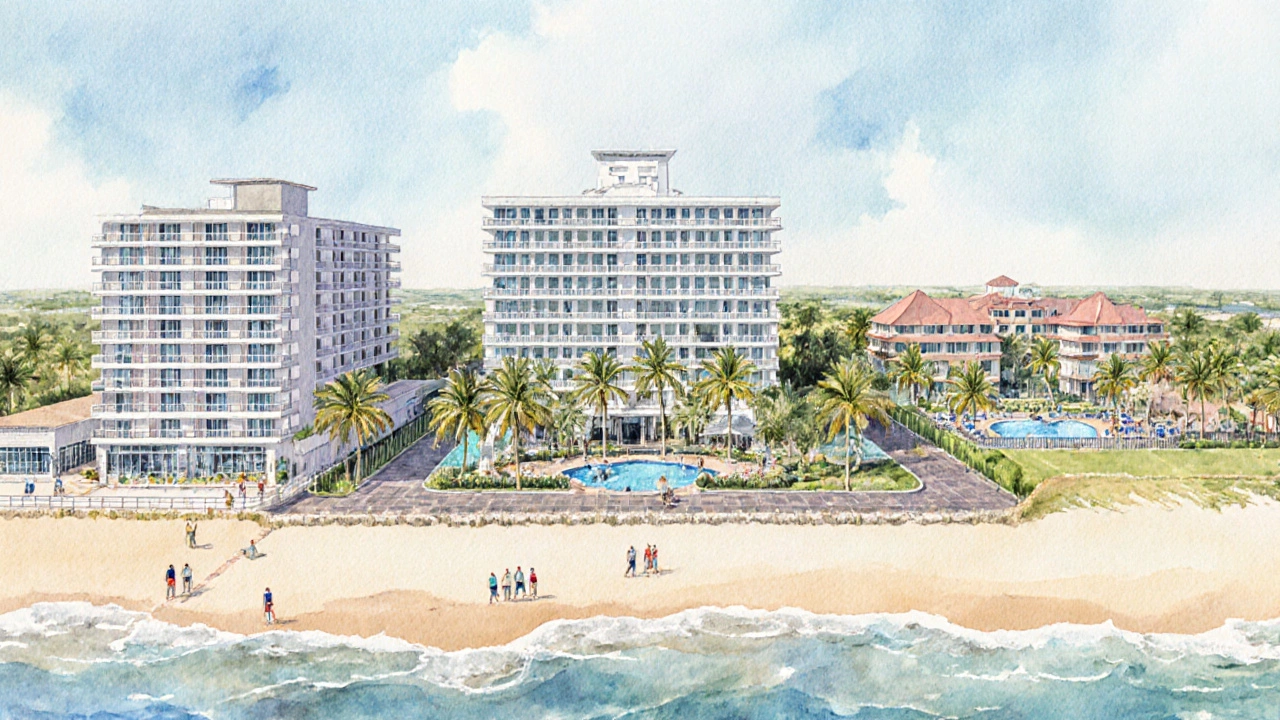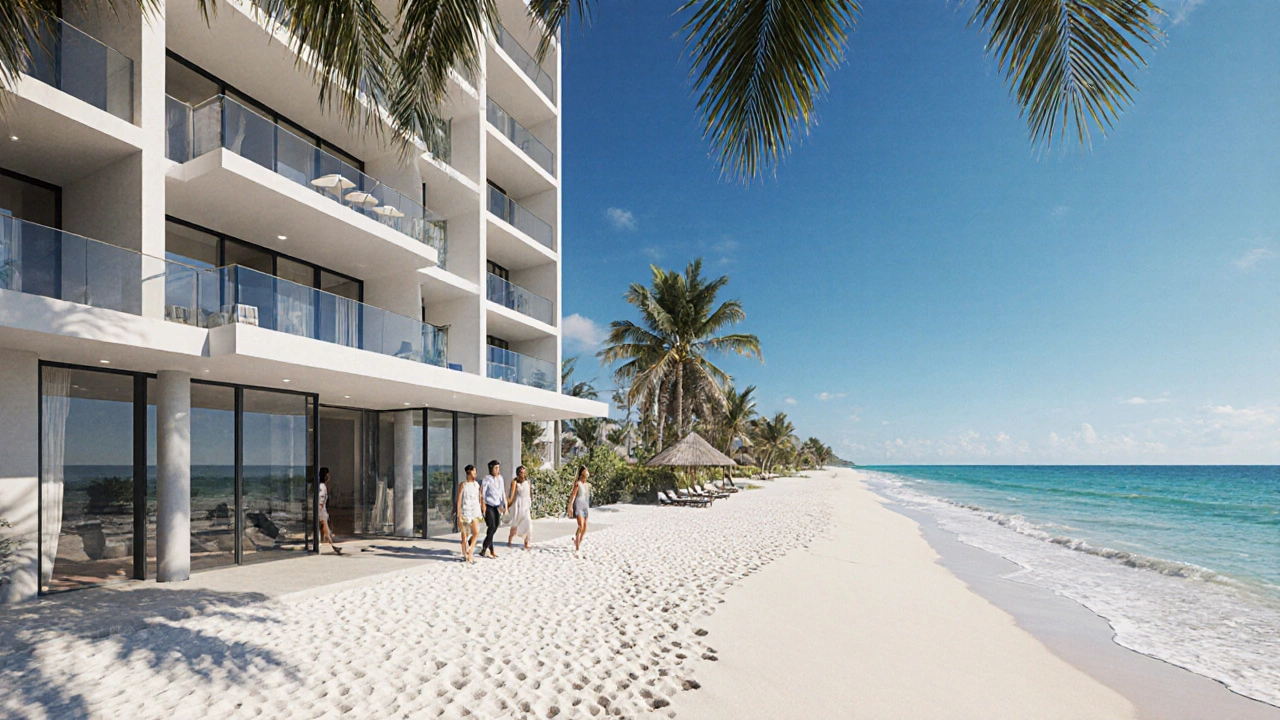Beachfront Hotel Comparison Tool
Find the perfect beachfront property by selecting your preferred distance from water. This tool shows matching property types, price premiums, and amenities based on industry standards from the article.
Your Match
Property Type
Price Premium
Core Amenities
When you see a hotel advertised as "beachfront," what does that actually guarantee? Is it just a marketing buzzword, or does it define a specific set of location and service standards? This guide breaks down the exact meaning of beachfront for hotels, how it impacts pricing, what amenities you can realistically expect, and how to spot genuine beachfront properties versus glossy hype.
Defining a Beachfront Hotel
Beachfront hotel is a hotel located directly on the shoreline, offering immediate access to the beach and unobstructed sea views. In practice, the property’s main entrance, pool, or dining areas sit less than 20 meters from the waterline, and the guest rooms either face the ocean or have private pathways to the sand. This is a stricter criterion than “ocean‑view,” which merely promises a visual connection without guaranteed beach proximity.
How the Industry Classifies Beachfront Labels
Hospitality regulators and travel associations often use three tiers to describe coastal lodging:
- Beachfront: Direct shoreline access, no intervening road or commercial strip.
- Oceanfront: Property sits on the coast but may be separated by a promenade, parking lot, or private green space.
- Seaside/Waterfront: Located near the water but typically behind a resort complex, marina, or residential area.
These distinctions matter because they affect everything from noise levels to the rate of sand in your room.
What Oceanfront hotel means
An oceanfront hotel provides an expansive sea view, yet the building may sit behind a paved promenade or a line of shops. Guests still enjoy the scenery, but the actual beach is a short walk away, often across a public pathway.
Seaside Resort vs. Beachfront Hotel
Seaside resort is a larger leisure complex situated near the coast, typically featuring multiple lodging options, multiple swimming pools, and a variety of dining venues. While some rooms may be beachfront, most are set back, and the resort’s branding leans on the “resort” experience rather than direct beach access.
Understanding these nuances helps you avoid paying premium rates for a room that only offers a distant view of the ocean.

Impact on Pricing: Why Beachfront Rooms Cost More
Data from the International Hotel Association (2024) shows that beachfront hotels command an average price premium of 28 % over comparable oceanfront properties. The premium is driven by three factors:
- Location scarcity: Prime shoreline real estate is limited, so owners charge for exclusivity.
- Maintenance costs: Salt air accelerates wear on building exteriors and furniture, raising upkeep expenses.
- Added amenities: Genuine beachfront venues often include private beach cabanas, beach‑side service, and sand‑proof rooms.
When budgeting, look for room‑type modifiers like “direct beach access” or “private sand pavilion” to gauge whether the price reflects true beachfront value.
Room Features You’ll Find at Authentic Beachfront Hotels
Below is a quick checklist of what to verify before booking:
- Private or semi‑private beach path within 5‑10 m of the lobby.
- Balcony or terrace that faces the sea without intervening structures.
- Sand‑resistant furnishings (e.g., teak, marine‑grade fabric).
- Room service that can deliver meals directly to the beach.
- Noise‑mitigating features such as double‑glazed windows to dampen wind and surf.
Typical Beachfront Amenities and Services
Beach access is a hallmark amenity that may include staffed lifeguard stations, sun‑lounger rentals, and complimentary water sports equipment. Expect the following additional perks at high‑end beachfront hotels:
- On‑site beachfront bar serving tropical cocktails.
- Sunset yoga sessions on the sand.
- Convenient beachfront shuttle to nearby attractions.
- Eco‑friendly sand‑cleaning initiatives that keep the shoreline pristine.
More budget‑oriented venues might limit services to basic lounge chairs and a beachfront café.

Choosing the Right Beachfront Property: A Decision Table
| Property Type | Distance to Water | Typical Price Premium | Core Amenities |
|---|---|---|---|
| Beachfront hotel | 0-20 m (direct access) | +28 % | Private beach, sea‑view rooms, beach‑side service |
| Oceanfront hotel | 20-50 m (promenade) | +12 % | Ocean views, easy beach walk, limited beach staff |
| Seaside resort | 50-150 m (complex grounds) | +5 % | Multiple pools, varied dining, indirect beach access |
| Waterfront property | 150+ m (river or harbor) | ±0 % | Harbor views, boat tours, no beach |
Booking Tips: Ensuring You Get True Beachfront Value
1. Read the fine print: Look for phrases like “steps to the beach” versus “beach‑adjacent”. 2. Check satellite maps on Google Earth; a true beachfront property will sit flush with the coastline. 3. Use third‑party reviews that mention "direct beach" or "sand under the room". 4. Contact the hotel directly and ask for a photo of the beach entrance. 5. If traveling off‑season, negotiate for a room upgrade that adds a balcony or patio.
Pros and Cons of Staying at a Beachfront Hotel
Pros
- Immediate access to sunrise swims and sunset strolls.
- Uninterrupted sea views from most rooms.
- Higher potential for romantic or social events on the sand.
Cons
- Higher nightly rates, especially during peak season.
- Exposure to salty air, which can affect electronics and skin.
- Potential for noise from surf and beach crowds.
FAQs About Beachfront Hotels
Is a "beachfront" label legally regulated?
There is no universal legal definition, but many tourism boards require proof of direct shoreline proximity for a property to market itself as beachfront. Always verify with photos or third‑party reviews.
Can a beachfront hotel have a private beach?
Yes. Luxury beachfront resorts often own a strip of sand exclusively for guests, marked by rope or signage. This adds to the premium price but guarantees fewer crowds.
Do beachfront rooms get sand inside?
Most high‑end beachfront properties use sand‑proof thresholds and regular cleaning services. Budget options might have simple mats; ask the hotel about housekeeping policies.
How does weather affect my beachfront stay?
Storms can temporarily close beach access and cause noisy winds. Choose hotels with indoor pool and lounge options for bad‑weather days.
Are beachfront hotels more eco‑friendly?
Many modern beachfront resorts adopt sustainable practices: solar panels, reef‑safe sunscreen dispensers, and beach clean‑up programs. Look for certifications like Green Key.
Understanding what "beachfront" truly means helps you match expectations with reality, avoid overpaying, and enjoy the sea exactly the way you imagined.

